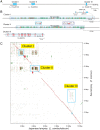Evolution of variable lymphocyte receptor B antibody loci in jawless vertebrates
- PMID: 34880135
- PMCID: PMC8685922
- DOI: 10.1073/pnas.2116522118
Evolution of variable lymphocyte receptor B antibody loci in jawless vertebrates
Abstract
Three types of variable lymphocyte receptor (VLR) genes, VLRA, VLRB, and VLRC, encode antigen recognition receptors in the extant jawless vertebrates, lampreys and hagfish. The somatically diversified repertoires of these VLRs are generated by serial stepwise copying of leucine-rich repeat (LRR) sequences into an incomplete germline VLR gene. Lymphocytes that express VLRA or VLRC are T cell-like, while VLRB-expressing cells are B cell-like. Here, we analyze the composition of the VLRB locus in different jawless vertebrates to elucidate its configuration and evolutionary modification. The incomplete germline VLRB genes of two hagfish species contain short noncoding intervening sequences, whereas germline VLRB genes in six representative lamprey species have much longer intervening sequences that exhibit notable genomic variation. Genomic clusters of potential LRR cassette donors, fragments of which are copied to complete VLRB gene assembly, are identified in Japanese lamprey and sea lamprey. In the sea lamprey, 428 LRR cassettes are located in five clusters spread over a total of 1.7 Mbp of chromosomal DNA. Preferential usage of the different donor cassettes for VLRB assemblage is characterized in our analysis, which reveals evolutionary modifications of the lamprey VLRB genes, elucidates the organization of the complex VLRB locus, and provides a comprehensive catalog of donor VLRB cassettes in sea lamprey and Japanese lamprey.
Keywords: adaptive immunity; immune system evolution; jawless vertebrates; transposable elements; variable lymphocyte receptor.
Conflict of interest statement
Competing interest statement: M.D.C. is a cofounder and shareholder of NovAb, Inc., which produces lamprey antibodies for biomedical purposes, and J.P.R. is a consultant for NovAb. One of the reviewers (T.B.) and three of the authors (S.D., M.H., and M.D.C.) contributed to a review article published online in 2017 (14).
Figures





Similar articles
-
Genomic donor cassette sharing during VLRA and VLRC assembly in jawless vertebrates.Proc Natl Acad Sci U S A. 2014 Oct 14;111(41):14828-33. doi: 10.1073/pnas.1415580111. Epub 2014 Sep 16. Proc Natl Acad Sci U S A. 2014. PMID: 25228758 Free PMC article.
-
Definition of a third VLR gene in hagfish.Proc Natl Acad Sci U S A. 2013 Sep 10;110(37):15013-8. doi: 10.1073/pnas.1314540110. Epub 2013 Aug 26. Proc Natl Acad Sci U S A. 2013. PMID: 23980174 Free PMC article.
-
Organization of lamprey variable lymphocyte receptor C locus and repertoire development.Proc Natl Acad Sci U S A. 2013 Apr 9;110(15):6043-8. doi: 10.1073/pnas.1302500110. Epub 2013 Mar 4. Proc Natl Acad Sci U S A. 2013. PMID: 23487799 Free PMC article.
-
Leveraging the biotechnological promise of the hagfish variable lymphocyte receptors: tools for aquatic microbial diseases.Fish Shellfish Immunol. 2024 Jul;150:109565. doi: 10.1016/j.fsi.2024.109565. Epub 2024 Apr 17. Fish Shellfish Immunol. 2024. PMID: 38636740 Review.
-
Two forms of adaptive immunity in vertebrates: similarities and differences.Adv Immunol. 2014;122:59-90. doi: 10.1016/B978-0-12-800267-4.00002-X. Adv Immunol. 2014. PMID: 24507155 Review.
Cited by
-
Molecular cues for immune cells from small leucine-rich repeat proteoglycans in their extracellular matrix-associated and free forms.Matrix Biol. 2023 Nov;123:48-58. doi: 10.1016/j.matbio.2023.10.001. Epub 2023 Oct 2. Matrix Biol. 2023. PMID: 37793508 Free PMC article. Review.
-
Evolution of two distinct variable lymphocyte receptors in lampreys: VLRD and VLRE.Cell Rep. 2023 Aug 29;42(8):112933. doi: 10.1016/j.celrep.2023.112933. Epub 2023 Aug 4. Cell Rep. 2023. PMID: 37542721 Free PMC article.
-
High throughput long-read sequencing of circulating lymphocytes of the evolutionarily distant sea lamprey reveals diversity and common elements of the variable lymphocyte receptor B (VLRB) repertoire.Front Immunol. 2024 Aug 7;15:1427075. doi: 10.3389/fimmu.2024.1427075. eCollection 2024. Front Immunol. 2024. PMID: 39170622 Free PMC article.
-
Adaptive immune receptor genotyping using the corecount program.Front Immunol. 2023 Apr 11;14:1125884. doi: 10.3389/fimmu.2023.1125884. eCollection 2023. Front Immunol. 2023. PMID: 37114042 Free PMC article.
-
Lampreys and spinal cord regeneration: "a very special claim on the interest of zoologists," 1830s-present.Front Cell Dev Biol. 2023 May 9;11:1113961. doi: 10.3389/fcell.2023.1113961. eCollection 2023. Front Cell Dev Biol. 2023. PMID: 37228651 Free PMC article.
References
-
- Litman G. W., Anderson M. K., Rast J. P., Evolution of antigen binding receptors. Annu. Rev. Immunol. 17, 109–147 (1999). - PubMed
-
- Cooper M. D., Alder M. N., The evolution of adaptive immune systems. Cell 124, 815–822 (2006). - PubMed
-
- Pancer Z., et al. , Somatic diversification of variable lymphocyte receptors in the agnathan sea lamprey. Nature 430, 174–180 (2004). - PubMed
-
- Alder M. N., et al. , Diversity and function of adaptive immune receptors in a jawless vertebrate. Science 310, 1970–1973 (2005). - PubMed
-
- Alder M. N., et al. , Antibody responses of variable lymphocyte receptors in the lamprey. Nat. Immunol. 9, 319–327 (2008). - PubMed
Publication types
MeSH terms
Substances
Grants and funding
LinkOut - more resources
Full Text Sources
Miscellaneous

